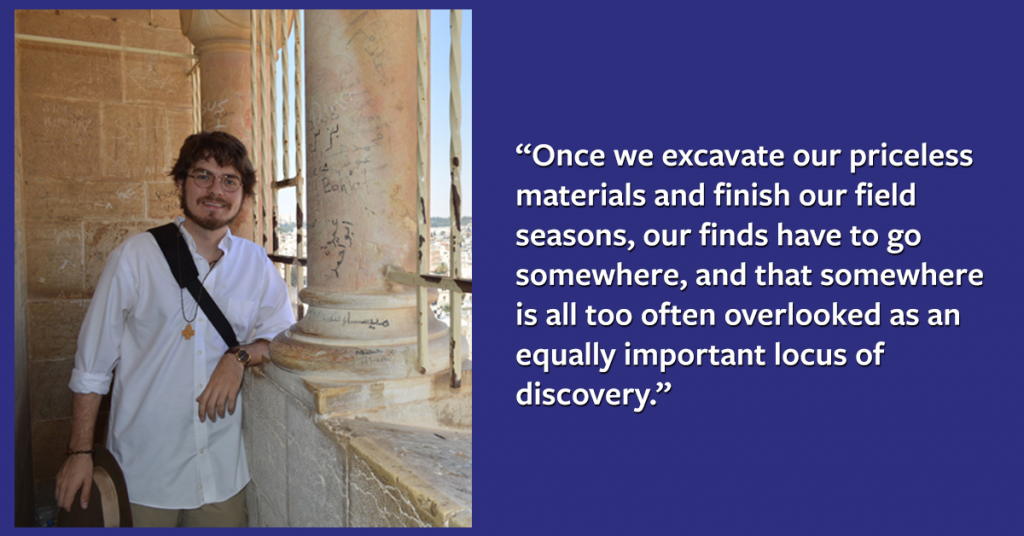“It Belongs in a Museum!”

By: Geoffrey Ludvik Sheeler Fellowship
Let’s be honest, excavation is the most glamorous part of archaeology. Digging is what an archaeologist dreams of. And it is this romantic aspect of archaeology that the media and wider public are entranced by. Rightly so! Excavation is amazing! As an area supervisor for the Tell el-Hesi Regional Project excavating the 10th century BCE tell site of Khirbet Summeily, I know that the thrill of these kinds of discoveries in the field are well worth the sweat and occasional blood and tears. But my summer in Israel this year proved to me that there is another place where we can peel back layers of history and uncover new and fascinating evidence about past cultures: the museum.
Inside the IAA Rockefeller Museum, with my bead impressions drying. The putty hardens and preserves a precise copy of the interior surfaces, allowing me to study the tools and abrasives used in bead production that varied from workshop to workshop in different areas of the ancient world.
As an archaeologist, I am “haunted” by a certain famous swashbuckling hero in a fedora and leather jacket. But for all his flaws, this gentleman’s zeal for museums is commendable. Once we excavate our priceless materials and finish our field seasons, our finds have to go somewhere, and that somewhere is all too often overlooked as an equally important locus of discovery. Museum and collections research is crucial in Near Eastern archaeology especially because archaeology itself is a destructive science. Once we remove an artifact from the ground, from its context, we can never put it back no matter how carefully we work; we destroy contexts as we study them. Often times what we record is all that will ever be said of an artifact, and what we miss will be missed forever. What happens, then, if we miss something big and don’t realize it? What if someone comes up with a question we never thought of? In a country with as long and as rich a tradition of excavation as Israel, it is no surprise that earlier excavators were not interested in certain research questions or lacked the methodological or scientific means to answer them. Well, this is where museum research proves its immense worth. While the contexts may be lost, the artifacts (hopefully!!!) are not. Especially in Israel, there exists an excellent system of artifact collection and permanent curation on the part of the Israel Antiquities Authority. Thus, future generations of scholars, armed with the proper accession numbers, can “re-excavate” old sites by visiting these museum depots and re-examining the artifacts.

Everyone needs to have a little fun. The Jerusalem Festival of Lights was certainly an interesting experience and an unexpectedly beautiful (if occasionally confusing) way to see the Old City by night. The walls and many monuments were lit up like Christmas trees, or better, like the Disney Castle in Orlando, and music and entertainment fills the streets. It was great!
This is exactly what I did during my dissertation research in Israel this summer. My project investigates the socio-political correlates of trade and interregional interaction in the southern Levant from 2500-1900 BCE. I do this using a class of artifacts typically underestimated by previous generations of scholars: hard stone beads. Given that beadmaking is prone to highly idiosyncratic differences in manufacturing technology, style, and raw material exploitation, it is likely that bead styles as well as production methods and sources varied from region to region, from workshop to workshop, and thus from culture to culture in the Eastern Mediterranean during this time period. I suggest that by isolating and defining discrete suites of stylistic, technological, and geological characteristics, it is possible to identify regional canons of bead types that can in turn be used help identify socio-political links between where the beads were made and where they were ultimately traded. I address these questions using traditional stylistic examinations of bead types alongside newly developed techniques for studying the technological facets of bead production, namely the making of vinyl polysiloxane impressions of bead drill holes for examination under scanning electron microscopes. These high-resolution techniques allow me to compare tool marks on experimental beads and archaeological artifacts to identify the types of drills used in production, a significant window into the technological know-how of different craft workshops. And the most exciting part? It is working! Were it not for the major museum collections of the Israel Antiquities Authority, my research would have been impossible and I would still be searching for a doctoral dissertation topic. So regarding the artifacts we excavate and considering the potential for scientific advancement by future generations, I happily echo my Nazi-punching, ark-raiding counterpart: they belong in museums!
~~~
All content provided on this blog is for informational purposes only. The American Schools of Oriental Research (ASOR) makes no representations as to the accuracy or completeness of any information on this blog or found by following any link on this blog. ASOR will not be liable for any errors or omissions in this information. ASOR will not be liable for any losses, injuries, or damages from the display or use of this information. The opinions expressed by Bloggers and those providing comments are theirs alone, and do not reflect the opinions of ASOR or any employee thereof.